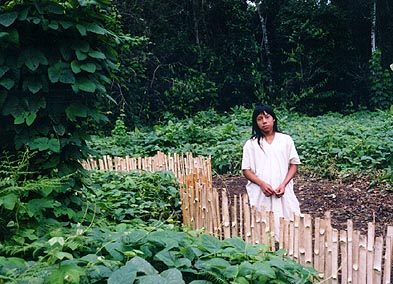
A verdant crop of "fertilizer" beans in the organic garden,
Casa de la Cultura, Lacanjá.
photo by R. Johnston

Lacandon agriculture: Sustainable use of the rainforest
Traditionally, the Lacandons practice a sustainable form of swidden or slash-and-burn horticulture by which they transform a small areas of natural forest into harvestable forest. Their three zones of food production are the pristine forest, milpa (cultivated fields) and the management of fallowed acahuales or pak che kol ("planted tree milpa"). The Lacandon system rotates milpa and fallowed areas while intercropping to maintain nutrient balance in the soil. This is in sharp contrast to the total exhaustion of the land from monocropping and livestock production practiced by their immigrant neighbors.Choosing a site to cut a small forest clearing for the milpa is the first crucial step. The Lacandons examine the natural vegetation to determine the best location. They know that breadnut and ceiba tree flourish on rich soil whereas areas where mahogany and cedar grow are too wet. Trees and underbrush are cut during January, February and March and allowed to dry. In mid April or early May, before the beginning of the rainy season, the dry underbrush is burned. Unlike temperate forests in North America, where the majority of nutrients are found in the soil, 75 percent of the nutrients in tropical forests are contained in the forest's living biomass and only 8 percent in the soil. Thus, burning the dried brush in a field, depositing a layer of fertilizing ash, is an effective means of placing the forest's nutrients in the soil.
Although the word milpa means corn field, it may produce over 80 kinds of food and fiber crops both above and below the soil. Once the field is burned, the farmer may wait a month to plant his main crop of corn, for he has to wait for the onset of the seasonal rains in June. Meanwhile he can sow both root and tree crops such as manioc, chayotes and bananas. Crops are planted through the season on a schedule timed by when certain forest species flower. This system coordinates planting with current environmental conditions, rather than a fixed callender. Hoping to keep away insects and reduce the risk of spreading disease, crops are planted in separate clusters. Daily weeding is what allows the Lacandon farmers to use the same plot of land for up to five years in a row.
When the old milpa gardens need to regenerate, they are planted with tree crops and are continued to be harvested for another five to fifteen years. These tree gardens, known as pak che kol, serve as a fallow area between milpa and primary forest. In the pak che kol, the Lacandon harvest many foods and other material. The strong fiber under the bark of the corkwood tree is used to make rope, strong carrier straps, and bark cloth for ceremonial garments. Fruits and nuts are harvested from these trees as well as roots and vines for baskets. These plants attract animals from the forest functioning as a "managed wildlife area" , providing an easy source of meat for the Lacandons.
The final ecozone of subsistence for the Lacandon is the primary forest, which yields a wide variety of plant and animal resources. The forest is a source of both food and raw materials for construction (wood for beams, thatch for roofing), tools (wood for bows and arrows, feathers for fletching, flint for projectile points and blades, plant fibre for twine), and crafts (clay for pottery, mineral and vegetable pigments for dyes, colourful seeds for necklaces). Many game animals live in the forest notably the Háale (paca or tepeizcuinte) prized for it's savory meat. Local lakes and rivers provide fish, shellfish, turtles and turtle eggs, snails and occasional crocodiles. Although rifles are mainly used for hunting, the bow and arrow is still occasionally used.
The Lacandons cycle of planting milpa, then pak che kol, then milpa can go on endlessly, keeping the use of primary forest to a minimum. Everything that the Lacandons need in daily life can be found in the milpa, pak che kol and the nearby forest. In emulating the diversity of the forest which surrounds it, the milpa gradually becomes a living mass of food producing plants which occupy the entire cleared area both above and below the soil. Their respect for the land and independence has allowed the Lacandons to survive until recently without assistance from the outside world for their daily needs.
Intensive mono-culture has proved a disaster for the new homesteaders in the Zona Lacandona. The traditional Lacandon agricultural system could serve as a basis for a modern sustained-yield agro-ecosystem. Unfortunately, present political and economic forces leave little room for enlightened development.
adapted from:
* "The evolutionary potential of Lacandon Maya sustained-yield tropical forest agriculture"
by James Nations & Ronald B. Nigh; Journal of Anthropological Research, (36(1) 1980.
* Life, Ritual and ReligionAmong the Lacandon Maya by R. Jon McGee
return to Contents * next page
Enlaces a otros sitios en la Web
THE LACANDON MAYA from PEOPLE OF THE TROPICAL RAINFOREST
IN GOOD HANDS: CULTURE AND AGRICULTURE IN THE LACANDON RAINFOREST
This page hosted by Geocities Get your own Free Home Page